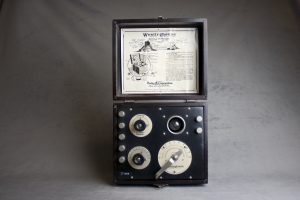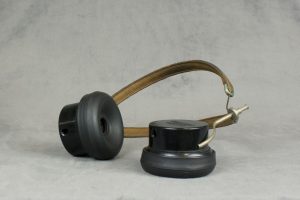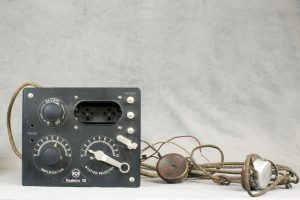The dream of a radio music box in every home
“I have in mind a plan of development which would make radio a ‘household utility.’ The idea is to bring music into the house by wireless.” – David Sarnoff
In 1915, David Sarnoff wrote a memo to his bosses referencing a so-called “radio music box,” a device that would wirelessly bring music into every household without the need of phonographic records or musical instruments. The memo went on to say that it would be entirely possible to have a radio transmitter installed at a place where music could be created or played, and later transmitted within the range of that transmitter. “The receiver,” Sarnoff wrote, “can be designed in the form of a simple ‘Radio Music Box’ and arranged for several different wave lengths, which should be changeable with the throwing of a single switch or pressing of a single button.” This radio music box would be equipped with the newly perfected technology of the vacuum tube, would be able to both pick up the signal and send it out through “loudspeaking telephones,” making the use of “head telephones” unnecessary. Sarnoff believed that each music box could be sold for $75 (roughly $1,000 today), creating enough revenue to not only make the music box, but also to help pay for the music, lectures, and sports games that were to be transmitted by this new technology. The profits, he concluded, could be tremendous. “It is not possible to estimate the total amount of business obtainable with this plan until it has been developed and actually tried out,” he wrote, “but there are about 15,000,000 families in the United States alone and if only one million or 7% of the total families thought well of the idea it would, at the figure mentioned, mean a gross business of about $75,000,000 which should yield considerable revenue.”[1]

This Radio Box Memo is firmly entrenched in the lore of RCA’s history, and it was a story that David Sarnoff himself was fond of telling. Historians now argue whether or not this memo was written at the time when Sarnoff claimed he wrote it,[2] and how much he was influenced by other experiments in radio broadcasting at the time, like Lee DeForest’s experimental transmissions of everything from a live production of Tosca at the New York Metropolitan Opera to a speech supporting women’s suffrage by Harriot Stanton Blatch (daughter to the suffragette Elizabeth Cady Stanton, and DeForest’s mother-in-law). Whatever the true history behind the writing of the memo, and the origin of the idea, Sarnoff convinced RCA to market a radio for the general public. This was the Aeriola Senior Receiver Radio, Type RF, built in East Pittsburgh by the Westinghouse Electric Corporation (RCA did not yet have its own manufacturing facilities). The set cost Sarnoff’s estimate of $75, but it did not include the cost of the vacuum tube, the antenna, the batteries, or the headset used to listen to it.

The first model came out in December of 1921, with a subsequent model (the model owned by the Sarnoff Collection) in January of the following year, and although it was made by Westinghouse, it was sold exclusively through RCA. In later models, the name was changed to the RCA Westinghouse Aeriola. The radio itself was housed in a small, lidded wooden cabinet, and unlike Sarnoff’s prediction, had to be listened to using a headset.

Radio caught on like wildfire, and RCA continued to sell more and more units. Alongside the Aeriola, RCA offered the Radiola line, with the Radiola I debuting in 1922, followed by the Radiola II in December of that year, and the wildly popular Radiola III (S. 366) released in 1924.[3] It was clear from the early 20s that Sarnoff’s original estimate of the number of American homes that would buy radios, to say nothing of his initial thoughts about the new technology’s profits, were wildly low. Within the first three years, RCA’s radio sales reached $83.5 million.[4] The radio was a huge success for RCA, not to mention for David Sarnoff’s career.
Text by: Florencia Pierri
Citations
[1] Radio Music Box memo, quoted in Gleason Leonard Archer, History of Radio to 1926 (New York: American Historical Society, 1938).
[2] Louise Benjamin, “In Search of the Sarnoff “Radio Music Box” Memo: Nally’s Reply,” Journal of Radio Studies 9, no. 1 (2002); Louise M. Benjamin, “In Search of the Sarnoff “Radio Music Box” Memo,” Journal of Broadcasting & Electronic Media 37, no. 3 (1993).
[3] Jerome S. Berg, On the Short Waves, 1923-1945 : Broadcast Listening in the Pioneer Days of Radio (Jefferson, N.C.: McFarland & Co., 2007).
[4] Marcy Carsey and Tom Werner, “Father Of Broadcasting,” Time Magazine, Dec. 07, 1998.

